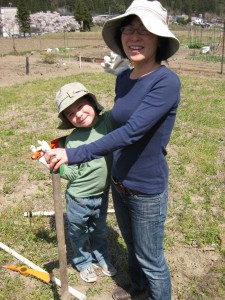 First thing, wanted to remind you that I also twitter here and I friend my readers on Facebook here. Onwards…
First thing, wanted to remind you that I also twitter here and I friend my readers on Facebook here. Onwards…
As you may know, Japan has lower per capita carbon emissions than any Western European country. For that reason, I asked my friend, Sean Saskamoto, who recently moved to Japan and who blogs at I’d Rather Be In Japan, to check in with us every so often. I thought we might be able to learn a little something about “happier planet, happlier people” lifestyles from Sean’s experience there.
Here is Sean’s latest dispatch:
Growing Your Own Food, Japanese-style by Sean Sakamoto
No matter where you go in Japan, one thing you’ll notice are the gardens. Even in fairly dense suburbs, every plot of land is meticulously tended, usually by the stooped figure of a grandmother or grandfather. My in-laws live in a tall apartment building in a packed suburb, with a wheat field on one side and a rice paddy on the other.
When people get old in this country, they work in their gardens. It doesn’t matter what time of year it is, or how bad the weather is. They’re out there in the brutal heat of summer, pulling weeds in the bone chilling damp of winter, planting tomatoes while surrounded by the spring cherry blossoms, and picking pumpkins as the Autumn leaves turn fiery red.
When vegetables ripen, it’s common to have a neighbor drop off a bag filled with cucumbers, beans or whatever bounty their garden has brought. It’s amazing 70 to 90 year old folks working so hard outside, and their vitality is inspiring.
During lunch time at the school where I work, the conversation invariably turns to what food is in season, and it goes beyond the garden to the forest. On weekends we go out in the woods with friends to pick whatever wild vegetables are in season. Last weekend we picked wild onions, ferns, and wasabe leaves. The weekend before that we picked bamboo shoots.
Everyone seems to have a relative with a plum tree, a chestnut tree, or some other kind of bush or shrub that gives up something to munch on at some time of the year. This close connection to nature reminds that food is part of a natural rhythm. Every meal is like a party, celebrating whatever came in that week. I like eating by the calendar.
Anticipating the grapes that come in late summer makes them that much sweeter when they finally burst in my mouth. The food that is grown locally, and eaten locally, also tastes so good because it’s so fresh. It isn’t bred for toughness over taste, or built to withstand weeks in passage to my plate. Anyone whose eaten a tomato at the peak of ripeness knows what I’m talking about. The same holds true for daikon, potatoes, squash, you name it. Just like bread is best the day it was baked, vegetables are best the day they were picked.
I wonder if the focus on fresh vegetables and the value of working hard in a garden is what keeps these senior Japanese neighbors of mine able to hoe a row at the age of 90? Is there a connection between a healthy old age and a deep interest in gardening and eating fresh fruit and vegetables year round? Even if there isn’t, the benefits of staying fit and eating well are plenty enough for me to give it a try.
The city rents out plots to garden for $50 a year. My family rented one (that’s my wife Noriko and my son Kazu in our plot in the picture above), and the first day we went out there and poked around, we had a bunch of old men giving us advice. People lent us tools, gave us drinks, and showed us how it’s done.
My son, Kazu, likes to play in the nearby stream while Noriko and I pull weeds and plant seedlings in the mud. It’s a nice, practically free way for a family to spend an afternoon. So far, we’re doing OK. Some bean plants and spinach are already starting to grow. With any luck, I’ll have a few bags of veggies to share with my neighbors by August.